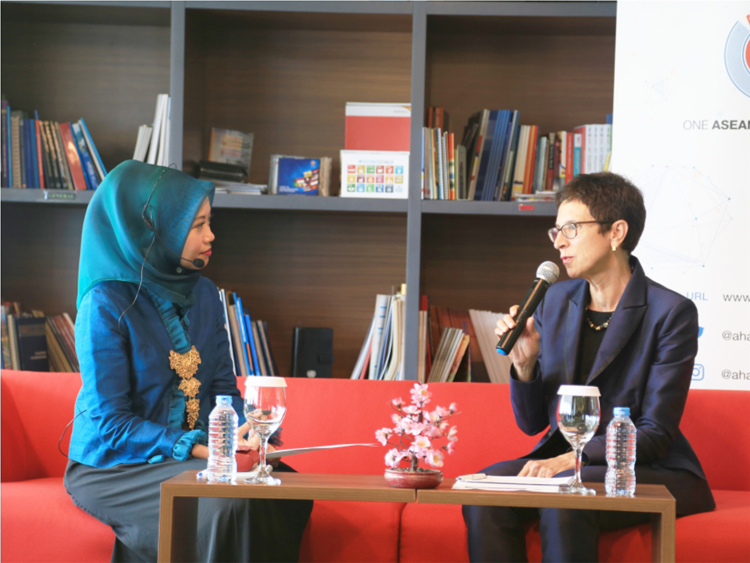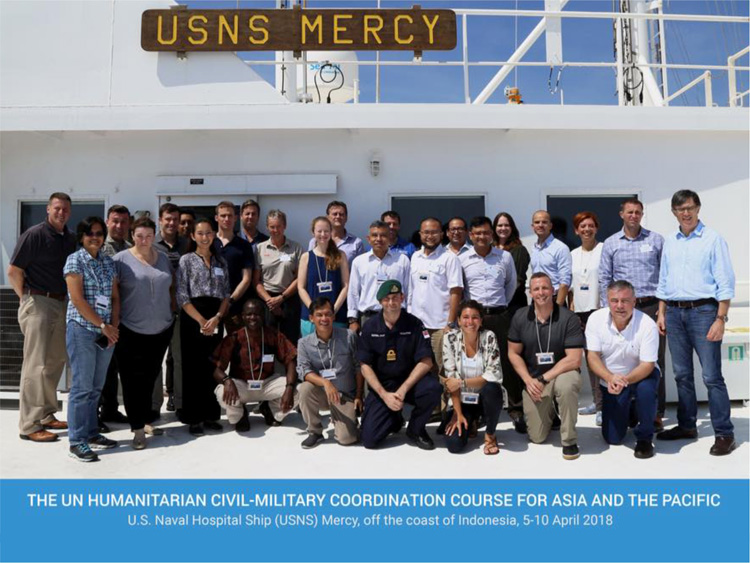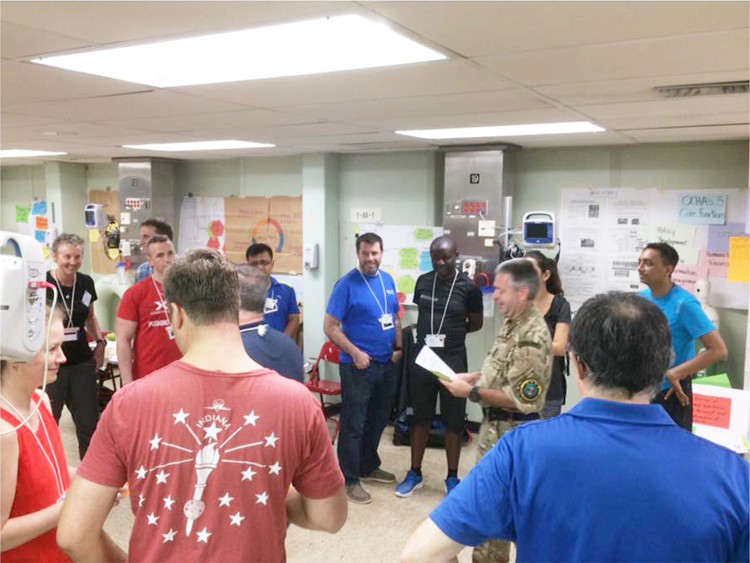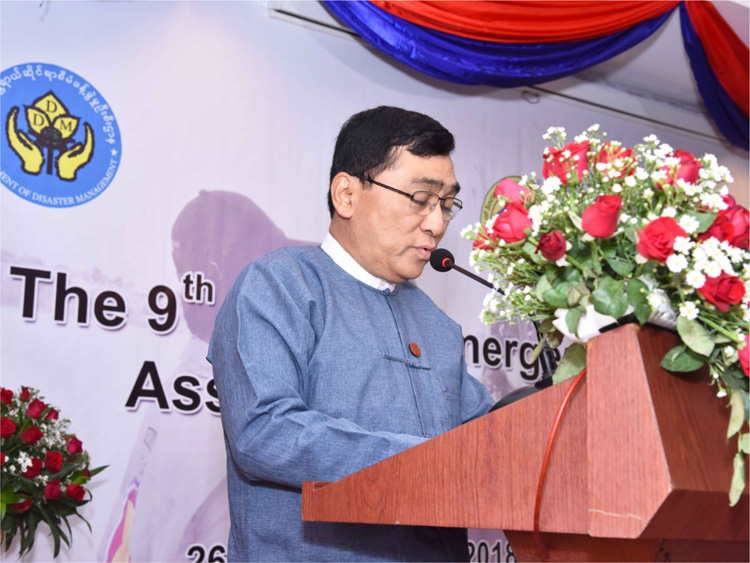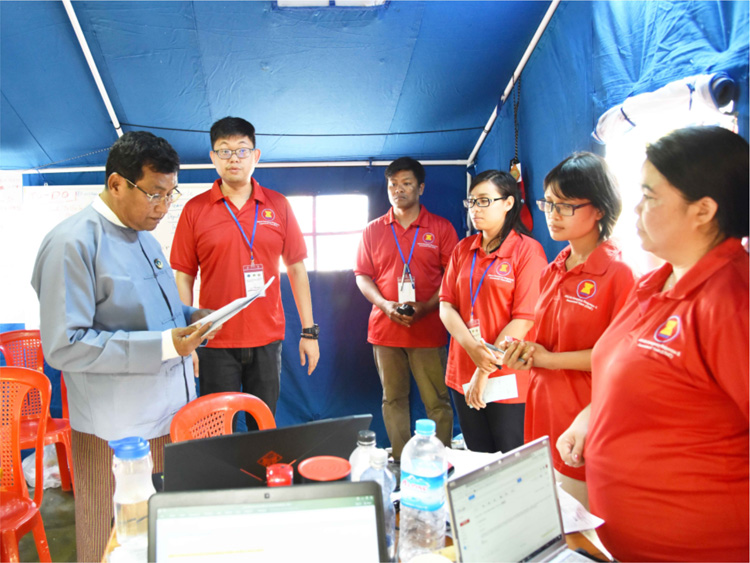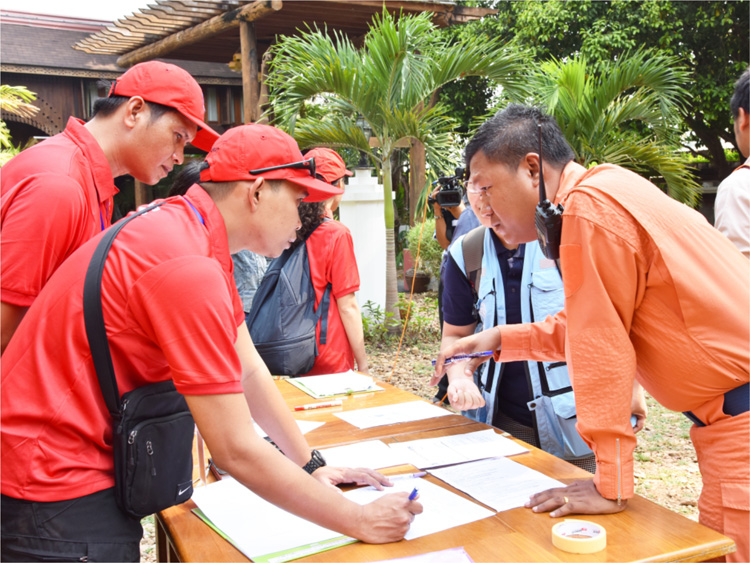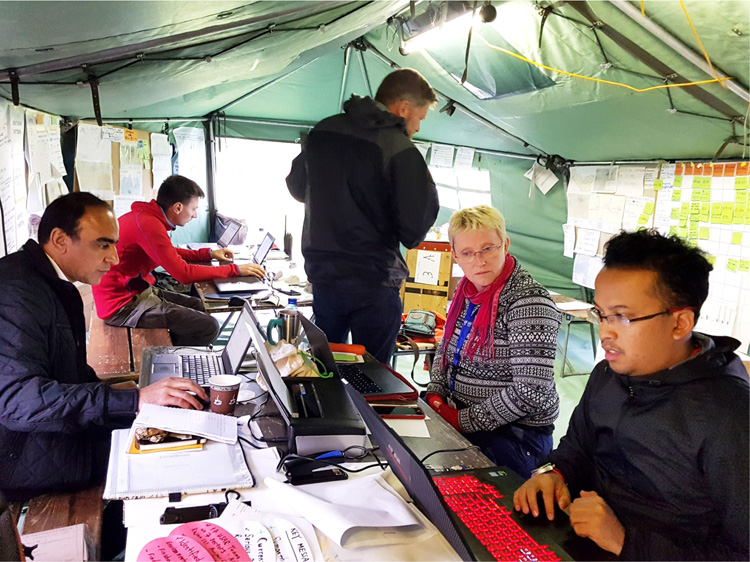Vol 38-H.E.Ursula Mueller

H.E. Ursula Mueller
United Nations Assistant Secretary-General for
Humanitarian Affairs and Deputy Emergency Relief Coordinator
IN EARLY APRIL 2018, THE AHA CENTRE HAD THE HONOUR OF MEETING H.E. URSULA MUELLER, THE UN’S ASSISTANT SECRETARY-GENERAL FOR HUMANITARIAN AFFAIRS AND DEPUTY EMERGENCY RELIEF COORDINATOR, WHO HAS BEEN A STRONG SUPPORTER OF GLOBAL HUMANITARIAN AND DEVELOPMENT AFFAIRS FOR OVER 30 YEARS. MS. MUELLER HAS DEVELOPED AN EXTENSIVE RANGE OF EXPERIENCES IN INTERNATIONAL AFFAIRS, THROUGH HER PREVIOUS ROLES AS GERMANY’S CIVIL COORDINATOR IN KOSOVO, GERMANY’S SPECIAL ENVOY TO AFGHANISTAN, DEPUTY DIRECTOR-GENERAL AT GERMANY’S MINISTRY OF FOREIGN AFFAIRS, AND DIRECTOR-GENERAL OF GERMANY’S MINISTRY OF ECONOMIC COOPERATION AND DEVELOPMENT.
She has also served as a member of the Advisory Board of the United Nations’ Central Emergency Response Fund (CERF), as well as to the United Nations Relief and Works Agency for Palestine Refugees in the Near East (UNWRA). Furthermore, her leadership in the role German Executive Director to the Board of Executive Directors of the World Bank Group between 2014 to 2017, resulted in stronger ties between the World Bank and the United Nations (UN).
Having the opportunity to engage with Assistant Secretary-General Mueller during her visit to the home of One ASEAN One Response in Jakarta, the Column’s editorial team gained valuable insights on regional and international cooperation for the provision humanitarian assistance. The humanitarian affairs partnership between ASEAN and the UN has progressed throughout the past 10 years, particularly after the devastation of Cyclone Nargis in Myanmar during 2008. Ms. Mueller stressed that ASEAN, the UN, and other global humanitarian stakeholders can deliver better results through working together.
During the discussion, Ms. Mueller highlighted the key strength of disaster management in the ASEAN region – namely the presence of a formal mandate, agreed-upon by all Member States. “You have a platform in which ten leaders have signed the Declaration on One ASEAN One Response. It gives you a very strong mandate to be relevant,” she said. “However, delivering on that mandate requires political support, financial support, and resources. Not only financial resources, but also relevant skills and standards that you can develop further through training.”
Ms. Mueller spoke about the importance of balanced partnerships, partnerships that suit the needs and context of both parties. She mentioned that fostering partnerships does not necessarily mean saying “yes” at every opportunity, but that often the real strength of a durable partnership can be knowing when it is appropriate to say “no” while, at the same time working together to find the best solutions to address humanitarian needs.
It is in the context of growing trust and partnership that the AHA Centre continues to work closely with UNOCHA to facilitate induction courses for the ASEAN Emergency Response and Assessment Team (ERAT) – as part of the ASEAN-ERAT Transformation Plan – which links closely to the curriculum of the United Nations Disaster Assessment and Coordination Team (UNDAC). As the international and regional humanitarian systems continue to develop, the need for coherence and interoperability between the coordination mechanisms managed at these various levels will be essential if we are to fulfil our collective mandate of meeting people’s needs by supporting the lead role played by governments. The priority must be that our respective processes and mechanisms complement, but do not duplicate each other, while assuring the ongoing safeguarding of the universally agreed humanitarian principles.
With regard to collective emergency response and the coordination roles of entities such as the AHA Centre and UNOCHA, ASG Mueller believes that preventative measures are more effective than a purely reactive approach. Thus, investing in early warning systems and preparedness should be considered as a top priority for the ASEAN region. Such investment will enable early action and improved coordinated responses at the regional level and support collective and synergised engagement in broader humanitarian challenges, including climate change, migration, drought, urbanisation, and human-induced disasters that cause displacement and human suffering.
Ms. Mueller is also a member of the International Gender Champions network – a group comprised of male and female leaders who aim to deconstruct gender barriers and establish gender equality through their leadership capacity. “It is important that we have the support of the men who are in positions of power,” she stated. “The Secretary-General of the UN has approved a gender parity strategy, which he is very committed to. Through women’s empowerment measures, we aim to achieve gender parity by 2028, as there is strong evidence that women’s engagement in peace-building and peacekeeping operations can positively impact the achievement of solutions.”
“In my own experience, in order to break the glass ceiling, you have to be professional, true to your values, also make your own contributions known” H.E. Mueller continued. “Your contribution to solving an issue deserves recognition, but you have to also be humble enough to know that it is not about yourself. You may be frustrated, but stay optimistic, realistic, and never give up,” Ms. Mueller stated, while sharing her tips as a leading woman in the humanitarian network.
Written by : Shintya Kurniawan | Photo: AHA Centre, United Nations
- Published in The Other Side
Vol 38-Humanitarian Civil-Military Coordination (UN-CMCOORD) Training

HUMANITARIAN CIVIL-MILITARY
COORDINATION (UN-CMCOORD) TRAINING
BENGKULU, 5-10 APRIL 2018
On 5th–10th of April 2018, the AHA Centre participated in a Humanitarian Civil-Military Coordination (UN-CMCOORD) training, conducted on-board the US Naval Hospital Ship (USNS) Mercy in Bengkulu, Indonesia. The training was implemented by the United Nations Office for the Coordination of Humanitarian Affairs (UNOCHA) alongside the United States Pacific Fleet.
As military institutions often play a significant role within emergency responses, there is a real need to foster meaningful collaboration between military actors, civilians, and other international humanitarian organisations. This sees UNOCHA facilitating trainings such as the UN-CMCOORD on a regular basis across the world. The training’s underlying principle is to create and share common understanding for the facilitation of the right assistance, to the right people, at the right time, and using the most appropriate methods during emergency response. The training included a variety of modules, such as coordination and sharing of resources, protection of civilians, and the security of humanitarian aid workers – an effort that has developed the global #NotATarget campaign.
The participants in the UN-CMCOORD training held a range of diverse backgrounds. Alongside military representatives and UNOCHA staff, representatives from non-governmental organisations, National Disaster Management Organisations, regional organisations, and the International Red Cross/Crescent Societies were also involved. However, this event stands as the first time such a training was conducted on a military vessel. The USNS Mercy was originally an oil tanker, redeveloped into a military medical hospital, complete with a surgery operation room for humanitarian assistance and disaster response operations.
“I found the environment and direct exposure to military responses throughout the training as a very insightful experience. Furthermore, the content on liaising, communicating and facilitating dialogues between civilian and military actors during emergency operations is also very crucial in the region, as military actors often are the first responders in emergency situations,” stated Janggam Adhityawarma, Assistant Director of Preparedness and Response, and the AHA Centre’s representative at the training.
Written by : Shintya Kurniawan | Photo : AHA Centre
- Published in AHA Centre Diary 1
Vol 38-The 9TH ASEAN-ERAT Induction Course

THE 9TH ASEAN-ERAT
INDUCTION COURSE
Ten years since its first ASEAN-ERAT deployment – to support the response to Cyclone Nargis in Myanmar – the AHA Centre conducted its 9th ASEAN-ERAT Induction Course from the 26th of March until the 1st of April 2018, in Nay Pyi Taw, Myanmar. With outstanding support from the Department of Disaster Management of Myanmar (DDM) as the host, the course was attended by 31 participants from nine of the ten ASEAN Member States. Participants came from an array of backgrounds, including National Disaster Management Organisations, Red Cross and Red Crescent Societies, Civil Society Organisations, Youth Groups, the ASEAN Secretariat, ASEAN Plus Three Emergency Rice Reserve (APTERR), and the AHA Centre itself. The 9th ASEAN-ERAT Induction Course was officially opened with an inspiring speech by Dr. Win Myat Aye, the Union Minister of Social Welfare, Relief and Resettlement of Myanmar.
One of the key features of the 9th course was the simulation exercise scenario – which engaged one of the ASEAN Contingency Plans for large scale disaster – namely a 7.2 magnitude earthquake in Metro Manila. Using this contingency plan scenario, the simulation exercise increased the feeling of authenticity for participants as they performed the ASEAN-ERAT core functions, including rapid damage and needs assessments and incoming ASEAN relief item facilitation. They also enacted the provision of on-site coordination support to the affected country’s local authorities, namely through the facilitation of coordination meetings between a range of ground-level stakeholders.
The simulation exercise also allowed ASEAN-ERAT participants to develop their working relationships with the United Nations Disaster Assessment and Coordination (UNDAC) team, as part of the continued development of inter-operability between the Joint Operations and Coordination Centre of ASEAN (JOCCA) and the UN On-site Coordination Centre. Other components including personnel and team safety and security, as well as working with media were also tested during the simulation exercise. By simulating this response as part of the ASEAN-ERAT course, the AHA Centre has further enhanced the streamlining and capacity of ASEAN-ERAT within the ASEAN Contingency Plan development process.
Of particular note was the enthusiasm and spirit of the participants to deliver results during the non-stop, 48-hour simulation exercise. Given its intensity, the diversity of participants’ backgrounds, and varying skills across the different nationalities, the final results were considerably strong. These diversities and challenges were raised throughout the debrief session, often identified as considerable factors in shared-learning and strengthening the team.
Participants also valued the engagement of a range of external parties, including the United Nations Office for the Coordination of Humanitarian Affairs (UNOCHA), the International Red Cross/Crescent Societies (IFRC), Map Action, Télécoms Sans Frontières, and Myanmar Red Cross amongst others, which provided them the opportunity to familiarise themselves with other key actors who would work alongside them in the field. This also allowed participants to see the importance of stakeholder engagement in achieving the vision of One ASEAN, One Response within the ASEAN-ERAT programme.
The successful completion of the 9th ASEAN-ERAT Induction Course, supported by the Japan-ASEAN Integration Fund (JAIF), alongside other previously-mentioned implementation partners, sees a current pool of 252 ASEAN-ERAT members across the region. Graduates were inaugurated during the Closing Ceremony by Ms. Adelina Kamal, Executive Director of the AHA Centre, together with the Deputy Minister of Social Welfare, Relief and Resettlement of Myanmar, Dr. U Soe Aung and Director General of DDM of Myanmar, Dr. Ko Ko Naing.
“We believe that the benefit of the ASEAN-ERAT goes beyond disaster response and that, because the ERAT teams are composed of government and NGO staff, participants are able to learn skills and get awareness of technologies and practices to take home and use in their current and future projects” – Sebastien Latouille, Delegate of Télécoms Sans Frontière.
“All of the new graduates should feel a great sense of pride. This very demanding course tested each of them and they all came through!” – Oliver Lacey-Hall, Head of UN-OCHA Indonesia/ASEAN Liaison Office.
“During the training, we made mistakes under the stress of the situation. But we could correct our mistakes and overcome the stress by working together and supporting each other as a team. We really appreciate the patience of our facilitators and mentors, for teaching us, for staying with us in the SimEx and sharing your knowledge and expertise with us” – Chan Nyein Thu, ASEAN-ERAT member Batch 9, Department of Disaster Management, Myanmar.
Written by: Grace Endina | Photo: AHA Centre
- Published in Highlight
Vol 39-Strengthening The Interoperability of ASEAN-ERAT and UNDAC

STRENGTHENING THE INTEROPERABILITY OF
ASEAN-ERAT AND UNDAC
SWITZERLAND, 29 APRIL – 11 MAY 2018
THE ASEAN REGION WAS REPRESENTED BY THREE MEMBERS OF THE REGION DURING THE UNITED NATIONS DISASTER ASSESSMENT AND COORDINATION (UNDAC) GLOBAL INDUCTION COURSE, HELD IN SWITZERLAND FROM THE 29TH OF APRIL TO THE 11TH OF MAY, 2018. THEIR INVOLVEMENT IN THE UNDAC TRAINING SERVES TO DEMONSTRATE THE STRENGTHENED PARTNERSHIP BETWEEN THE UNITED NATIONS AND ASEAN FOR INCREASING COLLECTIVE DISASTER PREPAREDNESS IN THE SOUTHEAST ASIAN REGION.
The participants, from Indonesia, Malaysia and Lao PDR, included two members of the ASEAN Emergency Response and Assessment Team (ASEAN-ERAT), thus their engagement in the UNDAC course formed another opportunity to test the interoperability between international and regional humanitarian mechanisms.
“The purpose of our involvement in the UNDAC course is to ensure quality learning process of UNDAC methodology and approach, increase the number of ASEAN-ERAT members who are also UNDAC-certified, as well as showcasing the quality of ASEAN-ERAT in collaborating together with other humanitarian actors within the UNDAC system,” said Dr. Mizan Bisri, the Disaster Monitoring and Analysis Officer of the AHA Centre, and one of the participants in the 2-week course.
At the completion of the course, numerous key-learnings could be identified, especially regarding points of improvement for adoption from UNDAC within ASEAN-ERAT processes. These included, amongst others, the strategic elements of coordination, access to assessment results, and back-end support mechanisms of UNDAC missions. A particular highlight is the strategic element of UNDAC system that forms a link between their assessment results and greater resource mobilisation, as well as public disclosure of such assessment results to increase the transparency of UNDAC and its standing in the wider humanitarian community. Therefore, dissemination of the assessment report produced by ASEAN-ERAT at the completion of each deployment/disaster response is increasingly important. While a response might not necessarily lead to greater resource mobilisation, having a public report will increase the visibility of ASEAN-ERAT, promote the values of ASEAN-ERAT, and potentially fortify the partnerships with global humanitarian partners.
The training also provided in-depth insights that may be integrated into the development of ASEAN-ERAT Level-2 curriculum, particularly related to rapid assessment, information management, logistics, humanitarian civil-military coordination and early recovery. The UNDAC holds a wide array of experiences designing back-end support with partner organisations, both within and outside of the UN system, particularly focused towards assessment and analysis, and information management aspects. Based on these experiences, within the Southeast Asian context, there are opportunities to enable ASEAN-ERAT members to provide remote support for ongoing missions on the ground.
During the UNDAC global induction course, ASEAN-ERAT was highlighted as a key regional partner for responding on the ground, capacity building and inter-operability preparedness. The ongoing participation between both ASEAN-ERAT and UNDAC within each other’s respective induction courses and exercises was highlighted and praised. UNDAC members also evidenced awareness that, in the case of disasters in ASEAN region, there is a great likelihood that a Joint Operations and Coordination Centre of ASEAN (JOCCA) would run in parallel to the Onsite Operations and Coordination Centre (OSOCC). Both centres would serve as coordinating platforms and provide support to the affected countries to manage incoming assistance. The existence of a Standard Operating Procedure between the OCHA/UNDAC and AHA Centre/ASEAN-ERAT, tailored to the respective UNDAC and ASEAN-ERAT mission cycles, was highlighted as a good institutional approach to ensure quality response for supporting the needs of the affected population. Overall, better strategic, tactical and operational linkages between ASEAN and UN agencies are fundamental to the holistic implementation of One ASEAN One Response, both for responding inside and outside the region. As of May 2018, there are 18 out of 252 ASEAN-ERAT members who had been trained and qualified as UNDAC personnel, with plans to continuously increase these numbers, in line with the ASEAN-ERAT Transformation Plan as part of the AHA Centre Work Plan 2020.
Written by : Mizan Bisri | Photo : AHA Centre, United Nations
- Published in AHA Centre Diary 1



